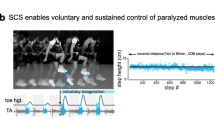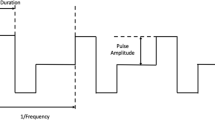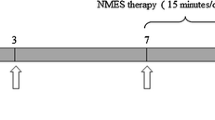Abstract
Spinal cord injury (SCI) is one of the most devastating injuries which causes either complete or partial loss of movement, balance, muscular coordination and endurance. Electromagnetic field (EMF) stimulation has been shown to reduce muscle atrophy and fiber-type switching and improves muscle function in a hindlimb suspension model. The present study aims to elucidate the therapeutic potential of EMF stimulation on motor neuron excitability, soleus muscle morphology and function in complete SCI rats. Thirty-six adult male Wistar rats were randomly divided into Sham, SCI and SCI+EMF groups. Complete transection was done at the T13 spinal level, followed by whole-body EMF exposure for 7 or 14 days. Hyper-reflexia, muscle atrophy, reduction in twitch and tetanic force with earlier onset of fatigue was evident in the SCI group. EMF stimulation showed significant improvement in H and M wave parameters, H/M ratio, muscle twitch and tetanic force, fusion frequency and fatigability. A significant increase in regenerating myofibers and reduction in muscle degeneration following EMF was evident on histopathological examination. Further, EMF significantly increased myogenic protein levels responsible for muscle regeneration. Our study demonstrates for the first time the potential of EMF to modulate motor neuron excitability and muscle contractile function in SCI rats through activity-dependent mechanisms.











Similar content being viewed by others
References
Beaulieu L and Schneider C 2013 Effects of repetitive peripheral magnetic stimulation on normal or impaired motor control. A review. Clin. Neurophysiol. 43 251–260
Calancie B, Broton JG, Klose KJ, et al. 1993 Evidence that alterations in presynaptic inhibition contribute to segmental hypo-and hyperexcitability after spinal cord injury in man. Electroencephalogr. Clin. Neurophysiol. 89 177–186
Chakraborty A, Arvind A, Srivastav S, et al. 2019 Demonstration of nerve muscle preparation in rats: for nerve-muscle physiology Teaching. IJPP 63 66–72
Chalfouh C, Guillou C, Hardouin J, et al. 2020 The regenerative effect of trans-spinal magnetic stimulation after spinal cord injury: mechanisms and pathways underlying the effect. Neurotherapeutics 17 2069–2088
Chin ER, Olson EN, Richardson JA, et al. 1998A A calcineurin-dependent transcriptional pathway controls skeletal muscle fiber type. Genes Dev. 12 2499–2509
Coletti D, Teodori L, Albertini MC, et al. 2007 Static magnetic fields enhance skeletal muscle differentiation in vitro by improving myoblast alignment. Cytometry A 71 846–856
Das S, Kumar S, Jain S, Avelev VD and Mathur R 2012 Exposure to ELF-magnetic field promotes restoration of sensori-motor functions in adult rats with hemisection of thoracic spinal cord. Electromagn. Biol. Med. 31 180–194
Dey S, Bose S, Kumar S, Rathore R, Mathur R and Jain S 2017 Extremely low frequency magnetic field protects injured spinal cord from the microglia-and iron-induced tissue damage. Electromagn. Biol. Med. 36 330–340
Dupont-Versteegden EE, Houlé JD, Gurley CM and Peterson CA 1998 Early changes in muscle fiber size and gene expression in response to spinal cord transection and exercise. Am. J. Physiol. Cell Physiol. 275 C 1124-C 1133
Dziki JL, Velayutham M, Hussey GS and Turnquist HR 2018 Cytokine networks in immune-mediated muscle regeneration. J. Tissue Eng. Regen. Med. 1 32–44
Graham ZA, Goldberger A, Azulai D, et al. 2020 Contusion spinal cord injury upregulates p53 protein expression in rat soleus muscle at multiple timepoints but not key senescence cytokines. Physiol. Rep. 8 e 14357
Guellich A, Negroni E, Decostre V, Demoule A and Coirault C 2014 Altered cross-bridge properties in skeletal muscle dystrophies. Front. Physiol. 5 393
Hofstoetter US, Danner SM, Freundl B, et al. 2015 Periodic modulation of repetitively elicited monosynaptic reflexes of the human lumbosacral spinal cord. J. Neurophysiol. 114 400–410
Howard EE, Pasiakos SM, Blesso CN, Fussell MA and Rodriguez NR 2020 Divergent roles of inflammation in skeletal muscle recovery from injury. Front. Physiol. 11 87
Iwamoto Y, Miyakoshi N, Matsunaga T, Kudo D and Saito K 2019 Effect of frequency-modulated repetitive peripheral magnetic stimulation (rPMS) on leg muscle atrophy in animal model. Int. J. Phys. Med. Rehab. 7 2
Järvinen TA, Józsa L, Kannus P, Järvinen TL and Järvinen M 2002 Organization and distribution of intramuscular connective tissue in normal and immobilized skeletal muscles. J. Muscle Res. Cell Motil. 23 245–254
Jayaraman A, Liu M, Ye F, Walter GA and Vandenborne K 2013 Regenerative responses in slow-and fast-twitch muscles following moderate contusion spinal cord injury and locomotor training. Eur. J. Appl. Physiol. 113 191–200
Jimena I, Tasset I, Lopez-Martos R, et al. 2009 Effects of magnetic stimulation on oxidative stress and skeletal muscle regeneration induced by mepivacaine in rat. J. Med. Chem. 5 44–49
Knikou M and Murray LM 2019 Repeated transspinal stimulation decreases soleus H-reflex excitability and restores spinal inhibition in human spinal cord injury. PloS One 14 e 0223135
Krishnan VS, Shin SS, Belegu V, et al. 2019 Multimodal evaluation of TMS-induced somatosensory plasticity and behavioral recovery in rats with contusion spinal cord injury. Front. Behav. Neurosci. 13 387
Kumar S, Jain S, Velpandian T, et al. 2013 Exposure to extremely low-frequency magnetic field restores spinal cord injury-induced tonic pain and its related neurotransmitter concentration in the brain. Electromagn. Biol. Med. 32 471–483
Lee JK, Emch GS, Johnson CS and Wrathall JR 2005 Effect of spinal cord injury severity on alterations of the H-reflex. Exp. Neurol. 196 430–440
Li Y and Bennett DJ 2003 Persistent sodium and calcium currents cause plateau potentials in motoneurons of chronic spinal rats. J. Neurophysiol. 90 857–869
Lieber RL, Fridén JO, Hargens AR and Feringa ER 1986 Long-term effects of spinal cord transection on fast and slow rat skeletal muscle: II. Morphometric Properties. Exp. Neurol. 91 435–448
Little JW, Ditunno JF Jr, Stiens SA and Harris RM 1999 Incomplete spinal cord injury: neuronal mechanisms of motor recovery and hyperreflexia. Arch. Phys. Med. Rehab. 80 587–599
Liu M, Bose P, Walter G, Thompson F and Vandenborne K 2008 A longitudinal study of skeletal muscle following spinal cord injury and locomotor training. Spinal Cord 46 488–493
Luo J, Zheng H, Zhang L, et al. 2017 High-frequency repetitive transcranial magnetic stimulation (rTMS) improves functional recovery by enhancing neurogenesis and activating BDNF/TrkB signaling in ischemic rats. Int. J. Mol. Sci. 18 455
Murray LM and Knikou M 2019 Transspinal stimulation increases motoneuron output of multiple segments in human spinal cord injury. Plos One 14 e 0213696
Pal A, Singh A, Nag TC, et al. 2013 Iron oxide nanoparticles and magnetic field exposure promote functional recovery by attenuating free radical-induced damage in rats with spinal cord transection. Int. J. Nanomed. 8 2259
Pal A, Kumar S, Jain S, Nag TC and Mathur R 2018 Neuroregenerative effects of electromagnetic field and magnetic nanoparticles on spinal cord injury in rats. J. Nanosci. 18 6756–6764
Palexas GN, Savage N and Isaacs H 1981 Characteristics of sarcoplasmic reticulum from normal and denervated rat skeletal muscle. Biochem. J. 200 11–15
Pall ML 2013 Electromagnetic fields act via activation of voltage-gated calcium channels to produce beneficial or adverse effects. J. Cell Mol. Med. 17 958–965
Petrosyan H, Liang L, Tesfa A, et al. 2020 Modulation of H-reflex responses and frequency-dependent depression by repetitive spinal electromagnetic stimulation: From rats to humans and back to chronic spinal cord injured rats. Eur. J. Neurosci. 52 4875–4889
Poirrier AL, Nyssen Y, Scholtes F, et al. 2004 Repetitive transcranial magnetic stimulation improves open field locomotor recovery after low but not high thoracic spinal cord compression-injury in adult rats. J. Neurosci. Res. 75 253–261
Reese N, Skinner R, Mitchell D, et al. 2006 Restoration of frequency-dependent depression of the H-reflex by passive exercise in spinal rats. Spinal Cord 44 28–34
Rosen AD 1992 Magnetic field influence on acetylcholine release at the neuromuscular junction. Am. J. Physiol. Cell Physiol. 262 C 1418-C 1422
Sayenko DG, Angeli C, Harkema SJ, Edgerton VR and Gerasimenko YP 2014 Neuromodulation of evoked muscle potentials induced by epidural spinal-cord stimulation in paralyzed individuals. J. Neurophysiol. 111 1088–1099
Schindler-Ivens S and Shields RK 2000 Low frequency depression of H-reflexes in humans with acute and chronic spinal-cord injury. Exp. Brain Res. 133 233–241
Schulte L, Peters D, Taylor J, Navarro J and Kandarian S 1994 Sarcoplasmic reticulum Ca2+ pump expression in denervated skeletal muscle. Am. J. Physiol. Cell Physiol. 267 C617–C622
Shields RK 2002 Muscular, skeletal, and neural adaptations following spinal cord injury. J. Orthop. Sports Phys. Ther. 32 65–74
Shimada Y, Sakuraba T, Matsunaga T, et al. 2006 Effects of therapeutic magnetic stimulation on acute muscle atrophy in rats after hindlimb suspension. Biomed. Res. 27 23–27
Skinner R, Houle J, Reese N, Berry C and Garcia-Rill E 1996 Effects of exercise and fetal spinal cord implants on the H-reflex in chronically spinalized adult rats. Brain Res. 729 127–131
Stern-Straeter J, Bonaterra GA, Kassner SS, et al. 2011 Impact of static magnetic fields on human myoblast cell cultures. Int. J. Mol. Med. 28 907–917
Stevens JE, Liu M, Bose P, et al. 2006 Changes in soleus muscle function and fiber morphology with one week of locomotor training in spinal cord contusion injured rats. J. Neurotrauma 231 671–1681
Stölting MN, Arnold AS, Haralampieva D, et al. 2016 Magnetic stimulation supports muscle and nerve regeneration after trauma in mice. Muscle Nerve 53 598–607
Stratton JA, Holmes A, Rosin NL, et al. 2018 Macrophages regulate Schwann cell maturation after nerve injury. Cell Rep. 24 2561–2572
Sun Z-C, Ge J-L, Guo B, et al. 2016 Extremely low frequency electromagnetic fields facilitate vesicle endocytosis by increasing presynaptic calcium channel expression at a central synapse. Sci. Rep. 6 21774
Talmadge RJ 2000 Myosin heavy chain isoform expression following reduced neuromuscular activity: potential regulatory mechanisms. Muscle Nerve 23 661–679
Talmadge R, Castro M, JrD Apple and Dudley G 2002 Phenotypic adaptations in human muscle fibers 6 and 24 wk after spinal cord injury. J. Appl. Physiol. 92 147–154
Tekieh T, Sasanpour P and Rafii-Tabar H 2016 Effects of electromagnetic field exposure on conduction and concentration of voltage gated calcium channels: A Brownian dynamics study. Brain Res. 1646 560–569
Thompson F, Reier P and Lucas Cand Parmer R 1992 Altered patterns of reflex excitability subsequent to contusion injury of the rat spinal cord. J. Neurophysiol. 68 1473–1486
Valero-Cabré A, Forés J and Navarro X 2004 Reorganization of reflex responses mediated by different afferent sensory fibers after spinal cord transection. J. Neurophysiol. 91 2838–2848
Yates C, Charlesworth A, Allen S, et al. 2008 The onset of hyperreflexia in the rat following complete spinal cord transection. Spinal Cord 46 798–803
Zheng Y, Mao YR, Yuan TF, Xu DS and Cheng LM 2020 Multimodal treatment for spinal cord injury: a sword of neuroregeneration upon neuromodulation. Neural Regen. Res. 15 1437
Acknowledgements
We acknowledge the help rendered by Purushottam Samal, Department of Physiology, AIIMS, New Delhi, and Anil Singh Bisht and Lal Bahadur Chaudhary, Department of Pathology, AIIMS, New Delhi, for their support in histological analysis.
Funding
This work was supported by the Indian Council of Medical Research, New Delhi, India, as a Senior Research Fellowship grant (Ref No: 45/10/ 2019-Nan/BMS).
Author information
Authors and Affiliations
Contributions
SJ conceived the project and obtained funding support; AC performed all the experimental work and wrote the initial draft of the manuscript; MCS performed muscle histology and analysis; and SV performed the statistical analysis. All the authors contributed to the conception and formalization of the study design, analysis and interpretation of data. AC and SJ were involved in acquiring data and drafting the work, revising it critically and approving the final version. MCS and SV contributed to the accuracy or integrity of the work and ensured that all the data are appropriately analyzed and interpreted.
Corresponding author
Ethics declarations
Author disclosure statement
AC, MCS, SV and SJ do not have any competing personal financial, funding, employment or other competing interests.
Institutional Review Board Statement
The study was approved by Institutional Animal Ethics Committee (Ethical number: 936/IAEC/ 2016) and was performed in accordance with the Laboratory Animal Welfare Act, the Guide for the Care and Use of Laboratory Animals (National Institutes of Health, Bethesda, MD, USA) and EU Directive 2010/63/EU for animal experiments.
Additional information
Corresponding editor: Shamik Sen
Rights and permissions
About this article
Cite this article
Chakraborty, A., Sharma, M.C., Vishnubhatla, S. et al. Electromagnetic field stimulation facilitates motor neuron excitability, myogenesis and muscle contractility in spinal cord transected rats. J Biosci 47, 78 (2022). https://doi.org/10.1007/s12038-022-00318-y
Received:
Accepted:
Published:
DOI: https://doi.org/10.1007/s12038-022-00318-y




